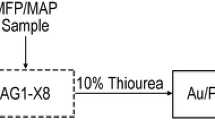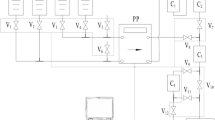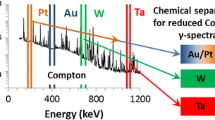Abstract
A rapid method for the separation and qualitative analysis of several neutron activation products (198Au, 192Ir, 72Ga, 51Cr, 191/195m/197Pt, 54Mn, 57Co, and 59Fe) from fission products and soil matrixes has been developed. Analytes were isolated within 20 h using ion exchange chromatography. After separation, the activation products were characterized by γ-spectroscopy and inductively coupled plasma-optical emission spectroscopy. Validation experiments demonstrated versatility of the method, showing that the activation products could be isolated from fresh fission products and other contaminants associated with complex soil matrixes.




Similar content being viewed by others
Notes
If Pb does not completely precipitate during the Pb precipitation step, it co-elutes with Co.
In the presence of soil matrix, Fe recoveries are not reproducible. In the absence of soil matrix, Fe recoveries were determined by ICP-OES to be near quantitative.
References
Horan JR (1963) The health physics aspects of the SL-1 accident. Health Phys 9:177–186
Mitsugashira T, Hara M, Nakanishi T et al (2000) Passive gamma-ray spectrometry for the determination of total fission events in the JCO criticality accident’99 in Tokai. J Environ Radioact 50:21–26. https://doi.org/10.1016/S0265-931X(00)00056-4
Imanaka T (2000) Neutron dose and power released by the JCO criticality accident in Tokai-mura. J Environ Radioact 50:15–20. https://doi.org/10.1016/S0265-931X(00)00055-2
Furuta K, Sasou K, Kubota R et al (2000) Human factor analysis of JCO criticality accident. Cogn Technol Work 2:182–203. https://doi.org/10.1007/PL00011501
Komura K, Yamamoto M, Muroyama T et al (2000) The JCO criticality accident at Tokai-mura, Japan: an overview of the sampling campaign and preliminary results. J Environ Radioact 50:3–14. https://doi.org/10.1016/S0265-931X(00)00054-0
Komura K, Yousef AM, Murata Y et al (2000) Activation of gold by the neutrons from the JCO accident. J Environ Radioact 50:77–82. https://doi.org/10.1016/S0265-931X(00)00064-3
Takada J, Hoshi M (2000) External doses to 350 m zone residents around the Tokai-mura criticality accident site. J Environ Radioact 50:43–48. https://doi.org/10.1016/S0265-931X(00)00059-X
Imanaka T (2001) Transport calculation of neutrons leaked to the surroundings of the facilities by the JCO criticality accident in Tokai-mura. J Radiat Res 42:S31–S44. https://doi.org/10.1269/jrr.42.S31
Tanaka S-I (2001) Summary of the JCO criticality accident in Tokai-mura and a dose assessment. J Radiat Res 42:S1–S9. https://doi.org/10.1269/jrr.42.S1
Selby JM, Moeller DW, Vallario EJ, Stephan JG (1986) Use of radiological accident experience in establishing appropriate perspectives in emergency planning. In: ANS topical meeting on radiological accidents—perspectives and emergency planning. Bethesda
McLaughlin TP, Monahan SP, Pruvost NL et al (2000) A review of criticality accidents. Los Alamos Lab, Los Alamos
Inaba J (2000) Radiological and environmental aspects of the criticality accident in Tokai-mura. Radiat Prot Dosimetry 92:239–246. https://doi.org/10.1093/oxfordjournals.rpd.a033277
Napier BA, Schmieman EA, Voitsekovitch O (2007) Radioactive waste management and environmental contamination issues at the Chernobyl site. Health Phys 93:441–451. https://doi.org/10.1097/01.HP.0000279602.34009.e3
Podlazov LN, Trekhov VE, Cherkashov YM et al (1994) Computational modeling of the accident in the fourth power-generating unit of the chernobyl nuclear power plant. At Energy 77:580–587. https://doi.org/10.1007/BF02407430
Kofuji H, Komura K, Yamada Y, Yamamoto M (2000) An estimation of fast neutron flux by reaction. J Environ Radioact 50:49–54. https://doi.org/10.1016/S0265-931X(00)00060-6
Muroyama T, Murata Y, Kofuji H et al (2000) Neutron activation of chemical reagents exposed to the neutrons released by the JCO criticality accident. J Environ Radioact 50:55–59. https://doi.org/10.1016/S0265-931X(00)00061-8
Evans JC, Lepel EL, Sanders RW et al (1984) Long-lived activation products in reactor materials. Pacific Northwest Lab, Richland
Buesseler K, Aoyama M, Fukasawa M (2011) Impacts of the Fukushima nuclear power plants on marine radioactivity. Environ Sci Technol 45:9931–9935. https://doi.org/10.1021/es202816c
Shozugawa K, Nogawa N, Matsuo M (2012) Deposition of fission and activation products after the Fukushima Dai-ichi nuclear power plant accident. Environ Pollut 163:243–247. https://doi.org/10.1016/j.envpol.2012.01.001
Schwantes JM, Orton CR, Clark RA (2012) Analysis of a nuclear accident: fission and activation product releases from the Fukushima Daiichi nuclear facility as remote indicators of source identification, extent of release, and state of damaged spent nuclear fuel. Environ Sci Technol 46:8621–8627. https://doi.org/10.1021/es300556m
Mattsson S, Finck R, Nilsson M (1980) Distribution of activation products from barsebäck nuclear power plant (Sweden) in the marine environment. Temporal and spatial variations as established by seaweed. Environ Pollut Ser B Chem Phys 1:105–115. https://doi.org/10.1016/0143-148X(80)90031-2
Le Petit G, Douysset G, Ducros G et al (2014) Analysis of radionuclide releases from the Fukushima Dai-Ichi nuclear power plant accident part I. Pure appl Geophys 171:629–644. https://doi.org/10.1007/s00024-012-0581-6
Achim P, Monfort M, Le Petit G et al (2014) Analysis of radionuclide releases from the Fukushima Dai-ichi nuclear power plant accident part II. Pure appl Geophys 171:645–667. https://doi.org/10.1007/s00024-012-0578-1
Donaldson LR, Seymour AH, Nevissi AE (1997) University of Washingtonʼs radioecological studies in the Marshall Islands, 1946–1977. Health Phys 73:214–222. https://doi.org/10.1097/00004032-199707000-00018
Oughton DH, Day JP (1993) Determination of cesium, rubidium and scandium in biological and environmental materials by neutron activation analysis. J Radioanal Nucl Chem Artic 174:177–185. https://doi.org/10.1007/BF02040345
Inaba J (2015) Environmental transfer parameters of radionuclides. Radioisotopes 64:335–349. https://doi.org/10.3769/radioisotopes.64.335
Warren GA, Runkle RC (2013) New concepts for radiometric measurements of environmental samples. J Radioanal Nucl Chem 296:829–833. https://doi.org/10.1007/s10967-012-2133-z
Winkler SR, Steier P, Carilli J (2012) Bomb fall-out 236U as a global oceanic tracer using an annually resolved coral core. Earth Planet Sci Lett 359–360:124–130. https://doi.org/10.1016/j.epsl.2012.10.004
Biegalski SR, Bowyer TW, Eslinger PW et al (2012) Analysis of data from sensitive U.S. monitoring stations for the Fukushima Dai-ichi nuclear reactor accident. J Environ Radioact 114:15–21. https://doi.org/10.1016/j.jenvrad.2011.11.007
Thakur P, Ballard S, Nelson R (2013) An overview of Fukushima radionuclides measured in the northern hemisphere. Sci Total Environ 458–460:577–613. https://doi.org/10.1016/j.scitotenv.2013.03.105
Quinto F, Golser R, Lagos M et al (2015) Accelerator mass spectrometry of actinides in ground- and seawater: an innovative method allowing for the simultaneous analysis of U, Np, Pu, Am, and Cm Isotopes below ppq levels. Anal Chem 87:5766–5773. https://doi.org/10.1021/acs.analchem.5b00980
Froehlich MB, Tims SG, Fallon SJ et al (2017) Nuclear weapons produced 236 U, 239 Pu and 240 Pu archived in a Porites Lutea coral from Enewetak Atoll. J Environ Radioact 178–179:349–353. https://doi.org/10.1016/j.jenvrad.2017.05.009
De Cesare M, De Cesare N, D’Onofrio A et al (2015) Mass and abundance 236 U sensitivities at CIRCE. Nucl Instrum Methods Phys Res Sect B Beam Interact Mater Atoms 361:483–487. https://doi.org/10.1016/j.nimb.2015.05.029
De Cesare M, Gialanella L, Rogalla D et al (2010) Actinides AMS at CIRCE in Caserta (Italy). Nucl Instrum Methods Phys Res Sect B Beam Interact with Mater Atoms 268:779–783. https://doi.org/10.1016/j.nimb.2009.10.029
Mahara Y, Kudo A (1995) Plutonium released by the Nagasaki A-bomb: mobility in the environment. Appl Radiat Isot 46:1191–1201. https://doi.org/10.1016/0969-8043(95)00161-6
Yuanzhong L, Jianzhu C (2002) Fission product release and its environment impact for normal reactor operations and for relevant accidents. Nucl Eng Des 218:81–90. https://doi.org/10.1016/S0029-5493(02)00200-5
Tadmor J (1976) Determination of the type and amount of fission products released in a nuclear reactor accident. Health Phys 30:95–112. https://doi.org/10.1097/00004032-197601000-00011
Hanson SK, Pollington AD, Waidmann CR et al (2016) Measurements of extinct fission products in nuclear bomb debris: determination of the yield of the Trinity nuclear test 70 y later. Proc Natl Acad Sci 113:8104–8108. https://doi.org/10.1073/pnas.1602792113
Goldstein SJ, Hinrichs KA, Nunn AJ et al (2018) Sequential chemical separations and multiple ion counting ICP-MS for 241Pu–241Am–237Np dating of environmental collections on a single aliquot. J Radioanal Nucl Chem 318:695–701. https://doi.org/10.1073/pnas.1602792113
Morrison SS (2015) Activation product analysis in the presence of fission products. Washington State University, Pullman
Kleinberg J (1990) Collected radiochemical and geochemical procedures. Los Alamos National Lab, Los Alamos
Dams R, Hoste J (1961) Gravimetric determination of tungsten by homogeneous precipitation. Talanta 8:664–672. https://doi.org/10.1016/0039-9140(61)80163-X
Willard HH, Goodspeed EW (1936) Separation of strontium, Barium, and lead from calcium and other metals—by precipitation as nitrates. Ind Eng Chem Anal Ed 8:414–418. https://doi.org/10.1021/ac50104a003
Laue CA, Gates-Anderson D, Fitch TE (2004) Dissolution of metallic uranium and its alloys. J Radioanal Nucl Chem 261:709–717. https://doi.org/10.1023/B:JRNC.0000037117.01721.f1
Gao J, Manard BT, Castro A et al (2017) Solid-phase extraction microfluidic devices for matrix removal in trace element assay of actinide materials. Talanta 167:8–13. https://doi.org/10.1016/j.talanta.2017.01.080
Montoya DP, Manard BT, Xu N (2016) Novel sample introduction system to reduce ICP-OES sample size for plutonium metal trace impurity determination. J Radioanal Nucl Chem 307:2009–2014. https://doi.org/10.1007/s10967-015-4648-6
Korob RO, Cohen IM, Agatiello OE (1976) Tungsten and molybdenum co-precipitation by α-benzoinoxime for activation analysis of tungsten. J Radioanal Chem 34:329–333. https://doi.org/10.1007/BF02519582
Knowles HB (1932) The use of alpha-benzoinoxime in the determination of molybdenum. Bur Stand J Res 9:1–8. https://doi.org/10.1016/S0016-0032(13)90386-0
Yagoda H, Fales HA (1938) Studies on the analytical chemistry of Tungsten and Molybdenum. II. J Am Chem Soc 60:640–643. https://doi.org/10.1021/ja01270a041
Taylor-Austin E (1937) The determination of molybdenum in cast iron. Analyst 62:107–117
Borgarello E, Serpone N, Emo G et al (1986) Light-induced reduction of rhodium(III) and palladium(II) on titanium dioxide dispersions and the selective photochemical separation and recovery of gold(III), platinum(IV), and rhodium(III) in chloride media. Inorg Chem 25:4499–4503. https://doi.org/10.1021/ic00245a010
Torigoe K, Esumi K (1992) Preparation of colloidal gold by photoreduction of tetracyanoaurate(1-)-cationic surfactant complexes. Langmuir 8:59–63. https://doi.org/10.1021/la00037a013
Acknowledgements
The authors are grateful for support from the Defense Threat Reduction Agency.
Author information
Authors and Affiliations
Corresponding author
Additional information
Publisher's Note
Springer Nature remains neutral with regard to jurisdictional claims in published maps and institutional affiliations.
Rights and permissions
About this article
Cite this article
Bennett, K.T., Kozimor, S.A., Manard, B.T. et al. Rapid activation product separations from fission products and soil matrixes. J Radioanal Nucl Chem 322, 281–289 (2019). https://doi.org/10.1007/s10967-019-06678-4
Received:
Published:
Issue Date:
DOI: https://doi.org/10.1007/s10967-019-06678-4




